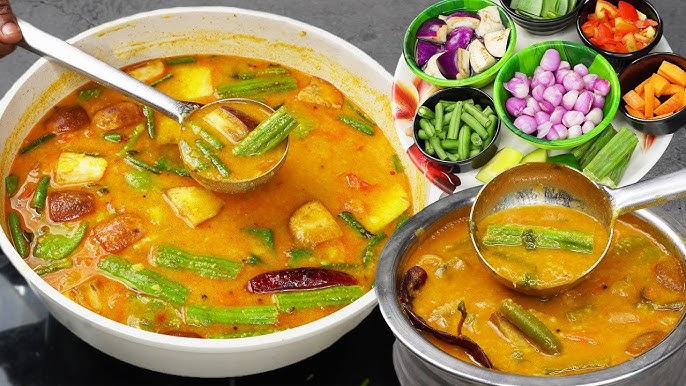Sambar is one of the most beloved dishes in South Indian cuisine. It’s a hearty, nutritious lentil and vegetable stew made with toor dal (pigeon peas), a blend of vegetables, and a unique spice mix called sambar powder. It’s tangy, spicy, and comforting – perfect with idli, dosa, rice, or even just on its own.
In this post, I’ll guide you through making authentic sambar at home with simple steps, helpful tips, and all the little tricks that make a big difference.
📝 Ingredients You’ll Need
Let’s break the ingredients into different categories for clarity.
For the Dal (Lentils):
- ½ cup toor dal (pigeon peas)
- 2 cups water (for cooking dal)
- ¼ tsp turmeric powder
- 1 tsp oil or ghee (optional – helps reduce froth)
For the Vegetables:
Use any mix of vegetables. Common choices include:
- 1 small carrot – chopped
- ½ drumstick – cut into 2-inch pieces
- 4-5 pieces of okra (lady’s finger)
- 1 small brinjal (eggplant) – chopped
- 1 small tomato – chopped
- 1 small onion – sliced (or use shallots for better flavor)
- A few curry leaves
For Tamarind Extract:
- Small lemon-sized ball of tamarind soaked in warm water (½ cup water)
- Squeeze and extract thick juice, strain if needed
For Sambar Powder:
If using store-bought, 1.5 tbsp is enough. Homemade sambar powder gives the best flavor.
For Tempering:
- 1 tbsp oil (or ghee for richer flavor)
- ½ tsp mustard seeds
- ½ tsp cumin seeds
- ¼ tsp fenugreek seeds
- 2 dry red chilies
- A pinch of asafoetida (hing)
- Few curry leaves
Optional Garnish:
- Chopped coriander leaves
🥣 Step-by-Step Preparation
Step 1: Cook the Toor Dal
- Wash the toor dal thoroughly 2–3 times until the water runs clear.
- Add it to a pressure cooker or Instant Pot with 2 cups of water, turmeric, and a few drops of oil or ghee.
- Cook for 3–4 whistles on medium flame (or 8–10 minutes in Instant Pot with natural pressure release).
- Once cooked, mash the dal well with a ladle or whisk until smooth and creamy. Set aside.
Tip: Always cook dal until it’s very soft. A well-cooked dal is the heart of good sambar.
Step 2: Prepare the Tamarind Water
- Soak the tamarind in warm water for 10–15 minutes.
- Squeeze it well to extract juice. Strain to remove pulp and fibers.
- Set aside about ½ cup of thick tamarind water.
Step 3: Chop and Prepare Vegetables
- Wash and chop all your vegetables into bite-sized pieces.
- In a large pot, add the chopped vegetables (except tomato and okra) with 1½ cups water and a pinch of turmeric.
- Cook until vegetables are 80% done – don’t overcook.
Tip: Add okra only toward the end to avoid sliminess. Tomatoes can be added with tamarind to retain their tangy flavor.
Step 4: Add Tamarind, Sambar Powder, and Simmer
- Once vegetables are half-cooked, add the tamarind extract and bring to a boil.
- Add salt and the sambar powder at this stage.
- Let this mixture simmer for 10–12 minutes on medium heat. This allows the raw smell of tamarind to go away and flavors to blend.
Step 5: Add the Cooked Dal
- Add the mashed dal to the simmering tamarind and vegetable mix.
- Mix everything well. Add more water if the sambar is too thick – the consistency should be pourable but not watery.
- Bring everything to a gentle boil and simmer for another 5–7 minutes.
Tip: The secret to a good sambar is simmering it long enough for the dal, tamarind, and spices to become one cohesive flavor.
Step 6: Prepare the Tempering (Tadka)
- In a small pan, heat 1 tbsp oil or ghee.
- Add mustard seeds and let them splutter.
- Add cumin, fenugreek seeds, dry red chilies, asafoetida, and curry leaves.
- Fry for a few seconds until aromatic. Be careful not to burn the spices.
- Pour the tempering immediately over the hot sambar.
Step 7: Final Touches
- Stir the sambar gently after adding the tempering.
- Taste and adjust salt, spice, or tanginess as needed.
- Garnish with fresh chopped coriander leaves.
- Cover with a lid and let it sit for 10–15 minutes before serving – this allows the flavors to deepen.
🍽️ How to Serve Sambar
Sambar is incredibly versatile. Here are some classic pairings:
- With steamed rice and a dollop of ghee – the most traditional South Indian meal.
- With idli or dosa – classic South Indian breakfast.
- With pongal, vada, or even plain upma.
- Some even enjoy sambar as a light soup.
🔄 Variations and Tips
- Sambar without onion/garlic: Skip the onions for a no-onion version, often made during festivals.
- Mixed vegetable sambar: Use pumpkin, beans, potatoes, and turnip for a colorful, hearty version.
- Hotel-style sambar: Add a tsp of jaggery or sugar to balance the tanginess – this gives it that slight sweetness found in restaurant sambar.
- Homemade sambar powder: If you love making things from scratch, try making your own sambar powder – it’s easy and can be stored for weeks.
🧂 Troubleshooting
- Too tangy? Add a little jaggery or more dal to balance.
- Too spicy? Add a little coconut milk or reduce the sambar powder next time.
- Too watery? Simmer longer to thicken, or mash a few pieces of vegetables.
🥄 Final Thoughts
Sambar may look like a simple lentil dish, but its beauty lies in the balance – the harmony between tangy tamarind, earthy dal, bold spices, and the variety of vegetables. Once you master the basic steps, you can play with variations endlessly.
Making sambar from scratch might seem long, but the results are absolutely worth it. Whether it’s for a Sunday lunch or a humble weekday meal, nothing satisfies quite like a bowl of hot, flavorful sambar.


